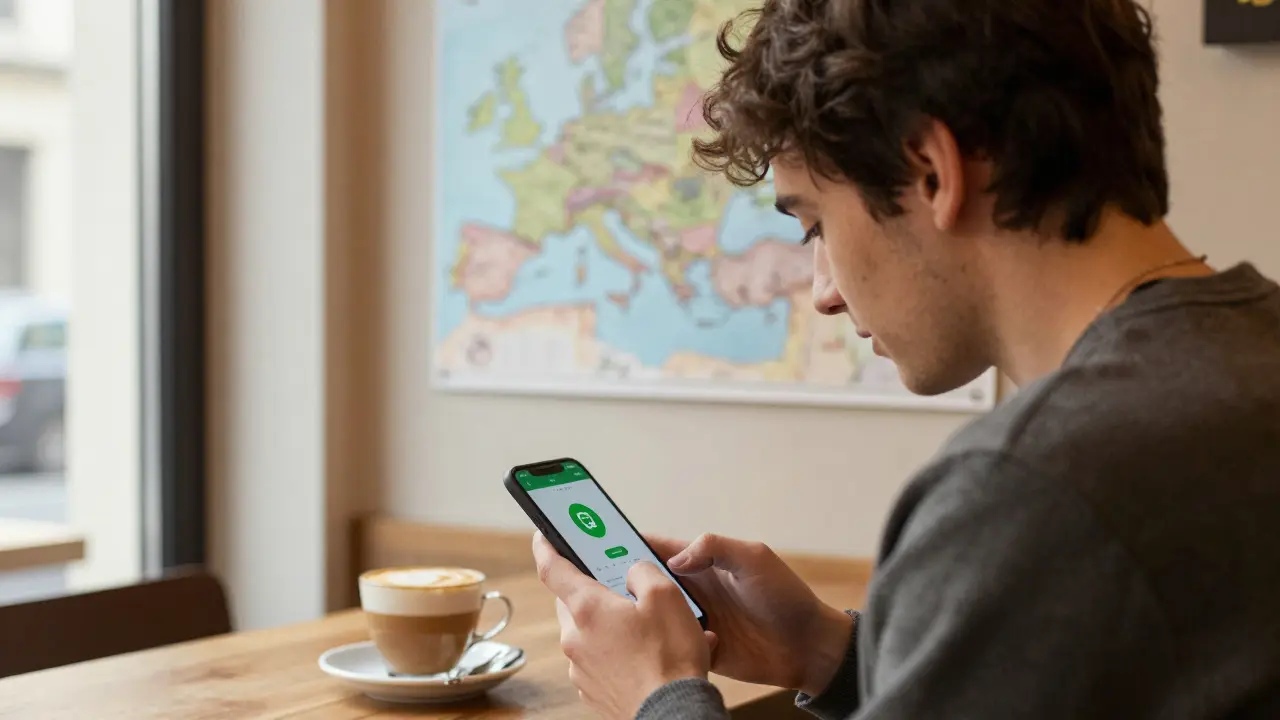Ever felt confused about whether a European guy is actually flirting with you or just being polite? You’re not alone. Flirting styles in Europe can look totally different from what you might expect if you grew up outside the continent.
Here’s the deal: European men often keep it subtle. You might get meaningful eye contact, small talk that feels a little deeper than usual, or even a cheesy but charming line in a cozy café. In some countries, men go for bold and direct (think Italian or Spanish guys asking for your number by the end of a short conversation), while in others, like Scandinavia or Germany, the approach is more reserved—think quiet compliments and witty banter instead of flirty touch.
The trick is knowing what signs to look for. Watch for those lingering looks, playful teasing, or a sudden shift from casual chat to personal topics. These signals are way more telling than just a compliment about your smile or your laugh.
Understanding how European men flirt makes conversations feel way less awkward and a whole lot more fun. If you’re curious about what actually counts as flirting over there, we’ll break down all the useful tips in the next sections, so you can spot interest without second-guessing every word.
- Direct Answer & Quick Facts
- Spotting Flirting Signals
- Cultural Differences in Flirting
- Dos and Don'ts When Flirting in Europe
- FAQ: Flirting With European Men
Direct Answer & Quick Facts
If you’re checking out the European dating scene, you’ll notice pretty quickly that flirting isn’t a one-size-fits-all deal here. So, how do European men flirt? They mostly use eye contact, relaxed body language, and witty banter rather than flashy pickup lines or big gestures. Cultural vibes are strong—guys from southern Europe (think Italy, Spain, Greece) often go bold, while northern and central guys (like Swedes or Germans) tend to play it cool and subtle.
- European men flirting is usually less loud than you might see in the US or Australia.
- Subtle signs like long looks, playful teasing, or random compliments are a big deal.
- Southern European men are known for direct flirting. They might ask you out quickly and show interest without hesitation.
- Guys in Western and Northern Europe lean more on humor, respect for personal space, and low-key touches, such as a gentle hand on your shoulder.
- Physical touch is more common in Mediterranean cultures but rare up north until there’s a clear mutual vibe.
Want a taste of how this plays out? Here’s a quick breakdown of flirting behaviors in different European regions:
| Region | Quick Facts |
|---|---|
| Southern Europe (Italy, Spain, Greece) | Direct, passionate, lots of eye contact and compliments |
| Western Europe (France, UK, Netherlands) | Charm, humor, playful banter, sometimes cheeky lines |
| Northern Europe (Sweden, Denmark, Germany) | Reserved, subtle signals, witty jokes, less initial touching |
| Eastern Europe (Poland, Russia, Hungary) | Gentlemanly, traditional, strong staring, polite compliments |
If you’re talking to a local and not sure if it’s flirting, ask yourself if the conversation feels a bit more personal—maybe they’re asking about your life, what you’re doing later, or giving you undivided attention. These are classic European signals that they’re into you.
Spotting Flirting Signals
When it comes to European men flirting, there isn’t a universal playbook, but there are clear signs if you know where to look. What counts as flirting in France might seem like friendliness in the Netherlands, and what feels bold in Italy might feel totally normal on a Spanish street. Still, a few telltale behaviors show up again and again.
The most reliable sign? Eye contact. In Southern Europe, guys tend to hold your gaze longer and pair it with a smile. In countries like France, Spain, or Italy, you might also get an eyebrow lift or a playful wink. This isn’t accidental—they’re likely interested if they make consistent, warm eye contact instead of just glancing and looking away.
Notice the conversation style, too. If a European guy is flirting, there’s often playful teasing or a sudden shift to personal topics. He might ask about your weekend plans, your favorite city, or slip in a compliment about something specific (like your choice in music or the way you laugh). Northern and Central European men are more reserved, so their flirting can look like subtle jokes, dry humor, or talking about shared interests.
Physical touch is another standout. In Mediterranean countries, a guy might casually touch your arm during a story, lean in close, or even brush your hair from your face if you're outdoors. But in Scandinavia or Germany, touching often comes much later and mostly happens after you’ve both shown mutual interest.
- Eye Contact: Longer, more meaningful than just passing glances
- Teasing: Light jokes, playful challenges, or poking gentle fun
- Compliments: Often about something unique, not just physical looks
- Personal Questions: Shifting the topic toward your life, family, or dreams
- Body Language: Leaning in, mirroring your gestures, relaxed posture
Not sure if it’s real flirting or just kindness? Check how often they reach out versus just being responsive—persistent attention is usually a sign. Also, Europeans tend not to overdo it with compliments, so if you get more than one, it’s probably genuine interest.
Here’s a quick glance at how some signals differ around Europe:
| Country | Eye Contact | Use of Touch | Directness |
|---|---|---|---|
| Italy | Very strong, smiling | Frequent, friendly | High |
| Sweden | Soft, quick checks | Rare, only after clear interest | Low |
| France | Sultry, playful | Moderate | Medium |
| Germany | Reserved, but present | Minimal | Medium-Low |
| Spain | Long stares, lots of smiling | Friendly, casual | High |
The fastest way to get better at noticing flirting is to chat with locals or watch how groups interact in busy bars or cafes. Every small gesture means something in European dating culture, so trusting your gut and the energy of the conversation usually steers you right.

Cultural Differences in Flirting
If you expect flirting in Europe to look the same everywhere, get ready for a surprise. Each country puts its own spin on flirting, and what feels romantic in Paris might look way too much in Oslo. You’ll want to know these differences so you don’t misread the signals (or accidentally embarrass yourself).
Let’s break down how flirting with European men changes as you move around the continent:
- Southern Europe (Italy, Spain, Greece): Flirting is often bold and direct. Don’t be shocked if a guy compliments you two minutes after you meet—he’s not being creepy, it’s just the local vibe. Expect good eye contact, playful physical touches (like a friendly touch on your arm), and quick moves to ask for your number or a date.
- Western Europe (France, Belgium, Netherlands): Here, the approach is a bit more refined but still confident. French men are pros at compliments and clever conversation. In the Netherlands, expect a more down-to-earth style—guys might flirt by making you laugh or teasing you lightly, but they don’t usually jump straight in with big gestures.
- Eastern Europe (Poland, Hungary, Russia): Flirting can feel more formal at first—think polite questions and respect for personal space. But when things warm up, men here might get quite expressive, and chivalrous gestures (like opening doors or offering a coat) are pretty common.
- Northern Europe (Sweden, Norway, Denmark, Finland): If a Scandinavian guy’s chatting to you for more than five minutes, he’s probably into you, even if he never says it outright! Here, people value equality and modesty, so flirting is super subtle—more about witty banter and gentle teasing, almost never direct physical moves.
Take a look at this table to see just how different flirting customs can be depending on where you are:
| Region | Style | Common Signals | Chance of Direct Invite |
|---|---|---|---|
| Southern Europe | Direct, expressive | Compliments, touch, strong eye contact | Very High |
| Western Europe | Confident, playful | Jokes, teasing, gentle compliments | Medium |
| Eastern Europe | Formal, chivalrous | Polite questions, chivalry, gradual escalation | Medium |
| Northern Europe | Subtle, understated | Witty chat, light teasing, few compliments | Low |
Remember, some things stay the same: confidence matters (even if it’s quiet), and respect for boundaries goes a long way. Try to match the pace and style of the person you’re talking to, and don’t take quietness as a lack of interest—especially in the north. If you’re ever unsure, it’s okay to just ask if they’re interested. Most Europeans will appreciate your honesty.
Dos and Don'ts When Flirting in Europe
If you’re thinking about getting flirty with a European guy, there are some clear moves that work—and a few that just don’t go over well. Every country has its vibe, but some tricks and pitfalls are the same pretty much everywhere. Let’s break them down so you can actually enjoy flirting instead of stressing about awkward moments.
- Do read the room. In most of Europe, subtlety is king. A genuine smile and relaxed body language work almost everywhere. If you’re too aggressive or loud right off the bat, people will probably get uncomfortable.
- Don’t rely on cheesy pickup lines. Especially in places like France or Germany, lines you see in movies usually land flat. Try a friendly compliment or just start with a casual question about their city or favorite food.
- Do respect personal space, especially in Northern Europe. Guys in Sweden or Denmark prefer a bit of distance until they know you better. Warm handshakes or a quick hug are fine in Southern Europe—like Spain or Italy—but don’t overdo the touching unless you’re sure he’s into it.
- Don’t confuse politeness for flirting. In some places, like the Netherlands, men are naturally friendly, even if they’re not interested romantically. If he’s asking a lot of personal questions and laughing at your jokes, then you’re likely crossing into real flirt territory.
- Do let the conversation flow naturally. Ask open questions and listen to his answers. European men are used to deeper chats and might steer clear if things feel superficial.
- Don’t rush into heavy flirting. In some countries, like Germany or Switzerland, a slow burn is the norm. Jumping straight to flirting hard can make you seem insincere.
- Do embrace cultural differences. If you don’t understand a reference or joke, just ask. Most people appreciate your interest in their culture and that builds instant connection.
- Don’t take rejection personally. In *any* dating or European men flirting situation, things won’t always go your way. If he says no, just move on. No awkwardness needed.
The big takeaway? Flirting in Europe is about paying attention, being open, and going at the right pace for the guy—and the country—you’re in. Try a little humor, keep things polite, and you’ll fit right in.

FAQ: Flirting With European Men
Trying to figure out what’s going on in the world of European men flirting? You’re definitely not the only one. These are some of the most common questions people ask, plus some local insights to keep you from misreading the signals.
1. Is flirting in Europe more direct than in other places?
It depends. Southern European men (think Italy, Spain, France) are usually more open and direct. Don’t be surprised if you get complimented on your looks within minutes. In places like Germany or the Netherlands, flirting tends to be more reserved. The compliments are real but not overly dramatic. A quick fact: an EU-wide survey in 2022 showed that two-thirds of Italians said they’d approach someone in person instead of by text, while in Sweden, only one in four would do the same.
2. Do European men use pickup lines?
You’ll definitely hear cheesy pickup lines in Latin countries! But most of the time, conversations start with a genuine question or comment about what you’re doing—like asking what you’re drinking or if you come to a club often. In Northern or Eastern Europe, expect more dry humor or just straight-up sincere talk—no Hollywood-style lines.
3. How do I know if a European guy really likes me?
- He finds excuses to spend time or talk with you.
- You get steady eye contact, not just glances.
- He might touch your arm lightly when laughing (common in Mediterranean countries).
- He remembers little things you said or did.
- If you exchange numbers, he actually messages you within a day or two.
4. Is it normal for European men to buy drinks or pay on dates?
There’s no single rule, but many Spanish or Italian men will insist on covering the first drink or coffee. Dutch and Scandinavian men tend to split bills (“going Dutch” really is a thing there). Don’t stress—if in doubt, just offer to share the cost. It’s not a test.
5. What attitudes should I watch out for?
Europe is pretty diverse on this front. In some countries, flirting can come across as persistent—but in places like France or Spain, it’s just part of the dance. Never feel pressured. If you’re uncomfortable, be direct. Most guys respect boundaries, and if not, it’s a red flag. Like Dutch dating author Sofie Kuijl says:
"The best European men know when to keep flirting light and step back when asked. It’s about mutual fun—not pushing limits."
6. Are language barriers a problem?
Sometimes, but honestly, flirting often relies more on body language, smiles, or little jokes. A study by Eurostat in 2023 found that 94% of younger Europeans (under 35) speak English well enough to flirt or date internationally. If things get lost in translation, just laugh and keep it simple—it works wonders.
| Country | Typical Flirting Style | Common Signal |
|---|---|---|
| Italy | Bold & Expressive | Frequent compliments, physical closeness |
| France | Sophisticated & Playful | Witty banter, lingering eye contact |
| Sweden | Chill & Subtle | Sincere questions, occasional smiles |
| Netherlands | Straightforward & Honest | Open talk about intentions, light jokes |
| Spain | Energetic & Fun | Lively conversation, close personal space |
Remember, if you’re not sure what’s happening, just ask or keep things light. Flirting is less about the country and more about having fun and being yourself. If you want to know more about signs and styles in specific places, try chatting with locals—they’re usually happy to help.






